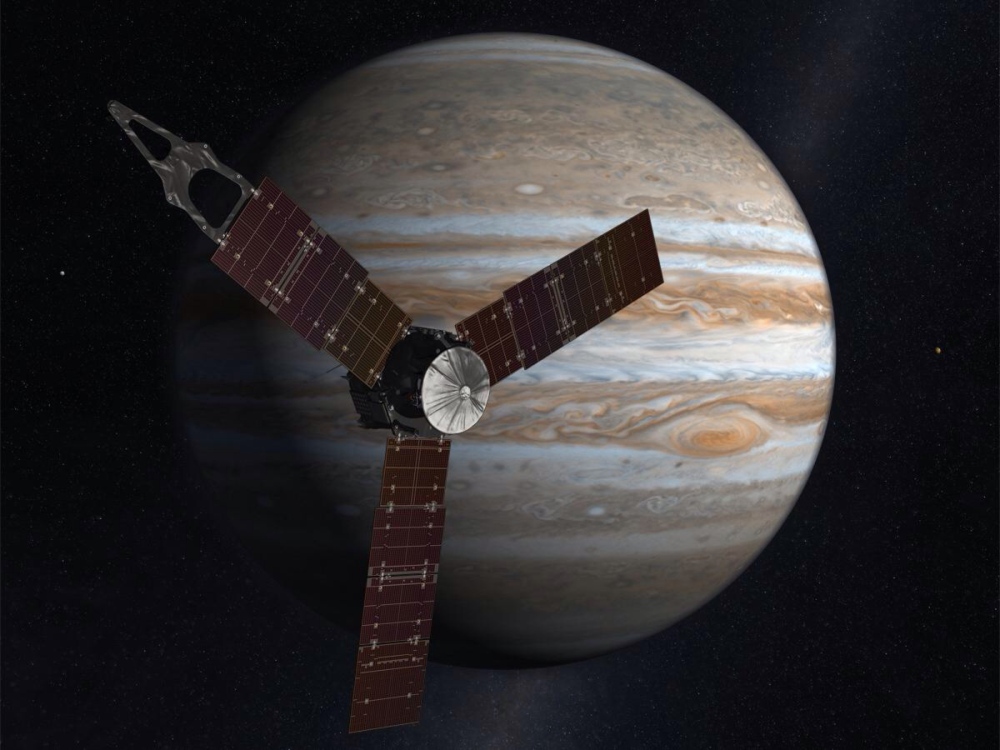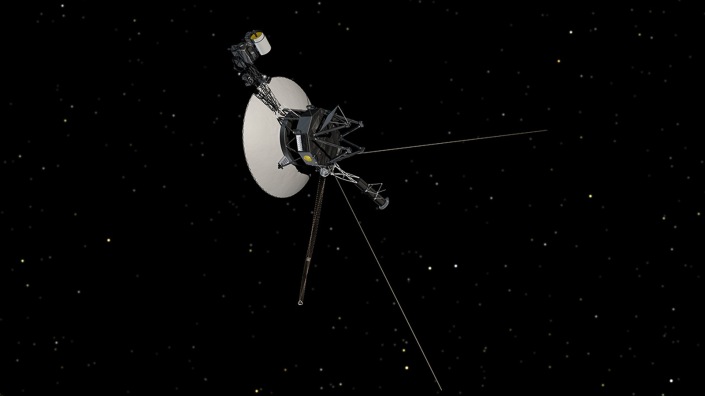Solar System
NASA’s Voyager 2 Probe Enters Interstellar Space
Dwayne Brown / Karen Fox
NASA Headquarters, Washington
Calla Cofield
Jet Propulsion Laboratory, Pasadena, Calif.

For the second time in history, a human-made object has reached the space between the stars. NASA’s Voyager 2 probe now has exited the heliosphere – the protective bubble of particles and magnetic fields created by the Sun.
Members of NASA’s Voyager team will discuss the findings at a news conference at 11 a.m. EST (8 a.m. PST) today at the meeting of the American Geophysical Union (AGU) in Washington. The news conference will stream live on the agency’s website.
Comparing data from different instruments aboard the trailblazing spacecraft, mission scientists determined the probe crossed the outer edge of the heliosphere on Nov. 5. This boundary, called the heliopause, is where the tenuous, hot solar wind meets the cold, dense interstellar medium. Its twin, Voyager 1, crossed this boundary in 2012, but Voyager 2 carries a working instrument that will provide first-of-its-kind observations of the nature of this gateway into interstellar space.
NASA Announces Coverage, Media Activities for Juno Mission Arrival at Jupiter

This Fourth of July, NASA’s solar-powered Juno spacecraft will arrive at Jupiter after an almost five-year journey. News briefings, photo opportunities and other media events will be held at NASA’s Jet Propulsion Laboratory (JPL) in Pasadena, California, and air live on NASA Television and the agency’s website.
Juno was launched August 5, 2011 from Cape Canaveral in Florida on an Atlas V rocket. It was estimated to take five years for the satellite to reach Jupiter, the only other gas giant without a dedicated satellite.
In the evening of July 4, Juno will perform a suspenseful orbit insertion maneuver, a 35-minute burn of its main engine, to slow the spacecraft by about 1,212 miles per hour (542 meters per second) so it can be captured into the gas giant’s orbit. Once in Jupiter’s orbit, the spacecraft will circle the Jovian world 37 times during 20 months, skimming to within 3,100 miles (5,000 kilometers) above the cloud tops. This is the first time a spacecraft will orbit the poles of Jupiter, providing new answers to ongoing mysteries about the planet’s core, composition and magnetic fields.
Juno will improve our understanding of the solar system’s beginnings by revealing the origin and evolution of Jupiter.
Specifically, Juno will…
- Determine how much water is in Jupiter’s atmosphere, which helps determine which planet formation theory is correct (or if new theories are needed)
- Look deep into Jupiter’s atmosphere to measure composition, temperature, cloud motions and other properties
- Map Jupiter’s magnetic and gravity fields, revealing the planet’s deep structure
- Explore and study Jupiter’s magnetosphere near the planet’s poles, especially the auroras – Jupiter’s northern and southern lights – providing new insights about how the planet’s enormous magnetic force field affects its atmosphere.
Juno’s principal goal is to understand the origin and evolution of Jupiter. Underneath its dense cloud cover, Jupiter safeguards secrets to the fundamental processes and conditions that governed our solar system during its formation. As our primary example of a giant planet, Jupiter can also provide critical knowledge for understanding the planetary systems being discovered around other stars.
With its suite of science instruments, Juno will investigate the existence of a solid planetary core, map Jupiter’s intense magnetic field, measure the amount of water and ammonia in the deep atmosphere, and observe the planet’s auroras.
While the events below are for the media, the public is invited to watch each of the events starting on June 16. The following are televised events are:
NASA TV Events Schedule
For all media briefings, reporters may ask questions by phone by contacting Gina Fontes at 818-354-9380 or georgina.d.fontes@jpl.nasa.gov. All times are Eastern.
Thursday, June 16
2 p.m. — Mission status briefing at NASA Headquarters in Washington
Thursday, June 30
4 p.m. — Mission overview news briefing at JPL
5 p.m. — Mission outreach briefing at JPL
Monday, July 4 – Orbit Insertion Day
Noon — Pre-orbit insertion briefing at JPL
10:30 p.m. — Orbit insertion and NASA TV commentary begin
Tuesday, July 5
1 a.m. — Post-orbit insertion briefing at JPL
To watch all of these events online, visit: http://www.nasa.gov/nasatv or http://www.ustream.tv/nasa or http://www.ustream.tv/nasajpl
Additional material on Juno’s mission was added from additional sources by George McGinn to add more about why these events are important to planetary science. – George McGinn
Voyager 1 Helps Solve Interstellar Medium Mystery

NASA’s Voyager 1 spacecraft made history in 2012 by entering interstellar space, leaving the planets and the solar wind behind. But observations from the pioneering probe were puzzling with regard to the magnetic field around it, as they differed from what scientists derived from observations by other spacecraft.
A new study offers fresh insights into this mystery. Writing in the Astrophysical Journal Letters, Nathan Schwadron of the University of New Hampshire, Durham, and colleagues reanalyzed magnetic field data from Voyager 1 and found that the direction of the magnetic field has been slowly turning ever since the spacecraft crossed into interstellar space. They believe this is an effect of the nearby boundary of the solar wind, a stream of charged particles that comes from the sun.
“This study provides very strong evidence that Voyager 1 is in a region where the magnetic field is being deflected by the solar wind,” said Schwadron, lead author of the study.
Researchers predict that in 10 years Voyager 1 will reach a more “pristine” region of the interstellar medium where the solar wind does not significantly influence the magnetic field.
Voyager 1’s crossing into interstellar space meant it had left the heliosphere — the bubble of solar wind surrounding our sun and the planets. Observations from Voyager’s instruments found that the particle density was 40 times greater outside this boundary than inside, confirming that it had indeed left the heliosphere.
But so far, Voyager 1’s observation of the direction of the local interstellar magnetic field is more than 40 degrees off from what other spacecraft have determined. The new study suggests this discrepancy exists because Voyager 1 is in a more distorted magnetic field just outside the heliopause, which is the boundary between the solar wind and the interstellar medium.
“If you think of the magnetic field as a rubber band stretched around a beach ball, that band is being deflected around the heliopause,” Schwadron said.
In 2009, NASA’s Interstellar Boundary Explorer (IBEX) discovered a “ribbon” of energetic neutral atoms that is thought to hold clues to the direction of the pristine interstellar magnetic field. The so-called “IBEX ribbon,” which forms a circular arc in the sky, remains mysterious, but scientists believe it is produced by a flow of neutral hydrogen atoms from the solar wind that were re-ionized in nearby interstellar space and then picked up electrons to become neutral again.
The new study uses multiple data sets to confirm that the magnetic field direction at the center of the IBEX ribbon is the same direction as the magnetic field in the pristine interstellar medium. Observations from the NASA/ESA Ulysses and SOHO spacecraft also support the new findings.
“All of these different data sets that have been collected over the last 25 years have been pointing toward the same meeting point in the field,” Schwadron said.
Over time, the study suggests, at increasing distances from the heliosphere, the magnetic field will be oriented more and more toward “true north,” as defined by the IBEX ribbon. By 2025, if the field around Voyager 1 continues to steadily turn, Voyager 1 will observe the same magnetic field direction as IBEX. That would signal Voyager 1’s arrival in a less distorted region of the interstellar medium.
“It’s an interesting way to look at the data. It gives a prediction of how long we’ll have to go before Voyager 1 is in the medium that’s no longer strongly perturbed,” said Ed Stone, Voyager project scientist, based at the California Institute of Technology in Pasadena, who was not involved in this study.
While Voyager 1 will continue delivering insights about interstellar space, its twin probe Voyager 2 is also expected to cross into the interstellar medium within the next few years. Voyager 2 will make additional observations of the magnetic field in interstellar space and help scientists refine their estimates.
Voyager 1 and Voyager 2 were launched 16 days apart in 1977. Both spacecraft flew by Jupiter and Saturn.
Voyager 2 also flew by Uranus and Neptune. Voyager 2, launched before Voyager 1, is the longest continuously operated spacecraft. Voyager 1 is the most distant object touched by human hands.
JPL, a division of Caltech, built the twin Voyager spacecraft and operates them for the Heliophysics Division within NASA’s Science Mission Directorate in Washington.
For more information about Voyager, visit: http://voyager.jpl.nasa.gov